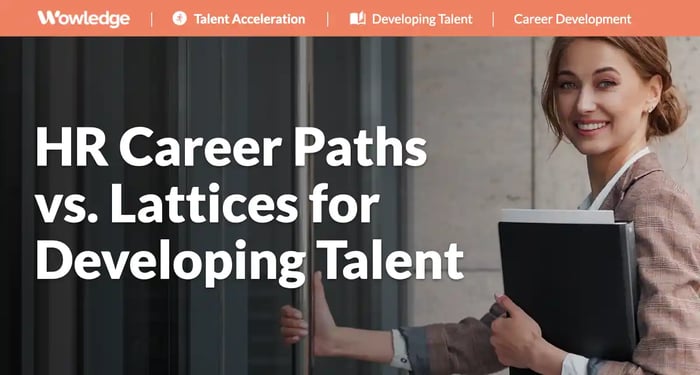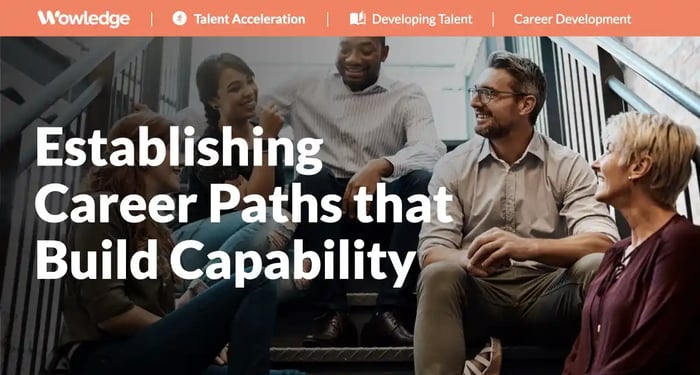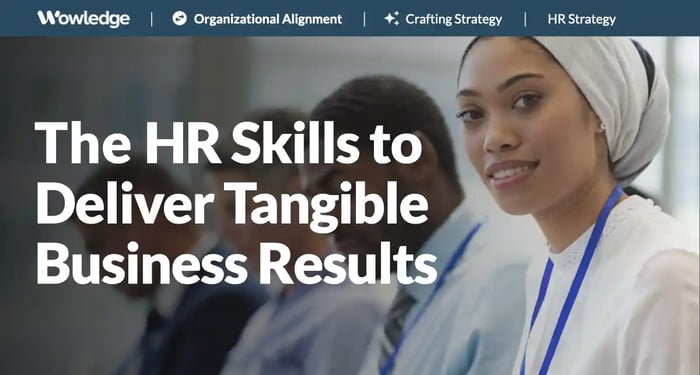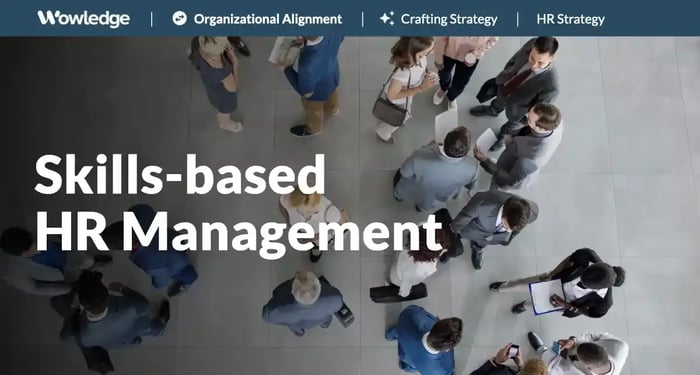Table of Contents
- Cross-disciplinary role development is crucial
- The reasons for prioritizing HR career path development and mobility
- Three critical steps for meaningful development through HR career lattices
- HR skill development priorities
- Opening up options for developmental mobility
- Bringing it together: rotating HR employees across a lattice
- Relevant Practices & Tools
- About Wowledge
An HR career is complex, with much to learn and master across the various Human Resources functions and operating model roles. Consider how different the requirements can be for a compensation professional, HR manager, benefits specialist, instructional designer, or recruiter. Each requires unique and deep technical expertise in their specialties’ development and deployment methods, policy and practice administration, and specialized technologies. They often have to deal with different sets of internal clients and have unique communications, feedback mechanisms, and possible connections to and influences on HR or corporate strategies. Crossing the various HR disciplines can be difficult, and developing broader skills requires a better solution for HR career paths.
As one ascends to senior individual contributor (IC) or management levels, the complexities of HR roles intensify. Cross-over skills such as strategic thinking, analytics, coaching, and business acumen become more prevalent. In a traditional progression of HR career paths, it becomes increasingly challenging for individuals to acquire and practice new skills, let alone explore and apply those used in other HR functions. This underscores the need for a new HR career path development concept to accommodate the evolving demands of the profession, workplace, and workforce.
With new pressures on HR teams to be agile and responsive to rapidly changing labor markets, skills bases and requirements, technology advancements, and generational preferences, HR skill development needs to move towards a faster and multi-disciplinary approach. Continuous learning can help combat new role requirements and skills obsolescence accompanying the increasing pace of automation and adopting intelligent (e.g., AI, machine learning) task support in HR. Having teams prepared to respond to business challenges with greater agility and responsiveness requires better-rounded HR professionals with a broader base of business and HR expertise that can be brought to bear on those challenges. Improving HR career paths to incorporate broader skill acquisition becomes essential.
Cross-disciplinary role development is crucial
The idea of development focused on classroom or eLearning training is past its prime. Developing a breadth of HR skills cannot occur by working one’s way up the ladder in one discipline. Similarly, the continuing call for HR employees who understand the businesses they support cannot be accomplished in the classroom alone. The fastest pathway toward expertise is learning through application—practicing the needed knowledge and awareness in real-time and live business circumstances. The value of working in different roles can best provide a mix of skills, methodologies, and solution sets that HR pros can use to understand and solve future business issues.
A well-established approach to career development in this vein is not new. It originated from Deloitte’s “career lattice” framework, which is a model that emphasizes the value of internal mobility separate from traditional career paths – upwards, across, and diagonally – inside and outside of a given job family. It encourages employee movement across traditional functional, professional, job level, and industry boundaries to add critical skills unavailable within the boundaries of a current assignment. This is similar to shifting from career paths to “career portfolios,” promoted many years ago as a robust employee development vehicle.
The reasons for prioritizing HR career path development and mobility
The labor market is pushing back on traditional career advancement
Research demonstrates that employee appetites are moving towards more mobility across functions and job families. McKinsey found that 48% of surveyed employees who quit moved to employers in different industries. A global sample found that 65% of those who quit did not return to the same industry, and 41% left jobs due to a lack of career development and advancement opportunities (consistent with a significant amount of data that suggests that job rotations help stave off unnecessary turnover.
And 84% of surveyed employees consider a shift from traditional career advancement models to careers as experiences as “important” or “very important.” The movement away from purely vertical advancement within a single field seen in HR career paths no longer meets the needs and expectations of today’s workers.
Jobs and work are changing significantly
The reality is that what was termed the “future of work,” which predicted significant changes in the nature of work, the workforce, and the workplace only a few years ago, is happening now. In a 2018 report, Deloitte found that 61% of companies were actively redesigning jobs around artificial intelligence (AI), robotics, and new business models. Meanwhile, another 42% believed that automation would soon significantly impact job roles.
Regarding career development, 72% of those responding companies said their career paths were not based on traditional job-family hierarchies. Even more concerning, 47% of them continued to base their development programs on the skills required for advancement through those traditional paths. A grave disconnect exists within HR career paths that need to be addressed.
Remarkable organizational benefits exist
A career lattice approach can yield a significant and favorable relationship between job rotation and employee performance, knowledge and skill development, and productivity. Job rotations increase employee well-being by helping them avoid feeling “stuck” in a job, providing opportunities to learn and advance their skill sets, and generating a fresh start and set of challenges.
Furthermore, SHRM reported that employees promoted in their first three years were 70% more likely to continue employment with their current organization, and those who made a lateral move were 62% more likely to be retained.
Other valuable business impacts include enhanced innovation through the sharing and transfer of cross-functional methods, enhanced collaboration through broader employee networks, increased adaptability to change, and a breaking down of traditional organizational silos that are created and maintained due to the use of HR career paths.
Employee benefits are robust
The value of a career lattice and mobility opportunities speak to the generational shifts mentioned above and provide opportunities for HR staffers (many of whom still feel the stresses of dealing with the pandemic, return-to-work policies, rapid hiring, and subsequent layoffs) with a range of valued outcomes. Unlike traditional HR career paths, it enables them to diversify their skills and experiences to mitigate the risks of obsolescence of skills or career options in the face of AI, chatbots, and other efficiency-focused automation adoptions. It supports their building a set of skills and experiences they would otherwise be unable to attain in the rigid confines of a career progression within a single function in a single company.
It brings a fresh perspective to their career ambitions by enabling employees to investigate the skill sets that might interest or better suit them while addressing the organization's future needs. It can help them create a portfolio “narrative” that ties their education, experiences, and skills to new jobs they aspire to hold. Ultimately, a better-rounded and skilled HR professional can bring enhanced value to the organization and experience more meaningfulness in the work they perform on its behalf.

Three critical steps for meaningful development through HR career lattices
1. Start with a solid foundation
Skill development through planful choices of roles and work experiences is beneficial for HR professionals, given the range and depth of disciplines that can be pursued. Traditionally, HR career paths and choices are forced early on, with a specialized role leading to more significant development in that discipline. However, it should only be considered a foundation for future skill and expertise expansion.
Choices tend to revolve around three conventional HR operating model elements: administrative (process, compliance, technology, or data-focused roles as in HR Shared Services), specialist (deep policy, program, practice, or technical expertise in Centers of Excellence or corporate HR), or business support (tailored and strategically aligned operational solutions, coaching, and guidance as in Generalist or Business Partner roles).
These three should be treated as a starting point based on their attractiveness and alignment with an individual's skills, mindset, and capabilities.
- Administrative experts tend to be focused on a single discipline and are experts in administrating and interpreting its policies, procedures, programs, and systems. They enjoy the details and nuances of applying those to changing regulatory, business, and labor market environments, communicating them to employees, and aligning those to the organization's needs.
- Specialists are highly skilled and experienced in a significant HR discipline, such as L&D, recruiting, or compensation. These require extended time to develop expertise in strategy definition, technical methods, policy development, plan or program administration, data analysis, systems, strategic business directions, and skill gaps. They also must look outside the organization to external sources of information and insights into best practices, emerging trends, and labor and economic market conditions. Becoming a strong specialist requires an appreciation of disciplined and researched approaches to building programs and practices that are financially viable and drive business outcomes.
- Generalists provide embedded and direct support to a segment of the business, leveraging knowledge and understanding of all aspects of HR. They interpret HR policies, help their assigned business units or departments comply with administrative process requirements, and coach and support employees and managers. In the more senior role of HRBP, they provide guidance, insights, and solutions to address business challenges and objectives. The roles are well-suited for those who can balance competing requests, needs, and business priorities. They tend to enjoy variety, have a passion for and ability to understand the business, and can build trusted relationships with senior leaders and managers.
2. Balance depth and breadth
Development through education and mobility through roles should always consider adding critical depth and breadth to an individual’s capabilities, knowledge, and skills. Understanding the mix of one’s interests, aspirations, skills, and competencies should drive the answer to the “what’s next” question. One’s aspirations and skills should be front and center when considering the next steps.
- Breadth: Moving towards a role as a generalist, HR Manager, Director, or HRBP will require a breadth of functional expertise in coaching, organization development, employee skills development, and recruiting, mixed with leadership and employee listening, process design and management, change management, and communications. Knowledge of the business is probably the most critical part of developing here. However, the business alignment learned in those roles is also essential experience for future COE or HRSS leaders who must design and develop. and administer enterprise-wide programs that are attuned to business realities and needs.
- Depth: Developing solid skills, expertise, and a track record of impact in compensation, recruiting, HR strategy, and L&D brings exposure and skills in skills crucial to higher-level jobs related to planning, budgeting, technology, process design, and workflow management. These also bring expanded opportunities to work with and learn from leaders in partner organizations in areas such as finance, information technology, procurement, and legal and compliance. The expanded understanding of how the organization operates and with whom to network when addressing different challenges is vital to success in higher-level roles, whether specialist or generalist.
3. Acquire business knowledge and expertise
Being a strategic HR professional requires understanding the business and its operations, whether in an administrative, specialist, or HRBP role. The foundations come from learning about the product or service development cycle, market research and product pricing decision processes, manufacturing and production and distribution workflows, partner and supplier relationships and contracting, sales and distribution practices, revenue collection and reporting, and customer service and support.
Given the skills gaps in traditionally raised HR professionals, the opportunity to develop a deep understanding of business operations and what drives or impedes their success is minimal. Getting HR professionals to develop the ability to regularly and comfortably work with analytics, understand how to motivate and focus sales teams, or improve productivity in manufacturing lines is critical to making an impact. The key to knowing the drivers and levers for success within and across the various business functions often comes from partnerships and actual experiences with line organizations. An MBA degree might be helpful, but actual experience in those operations is invaluable, and current HR career paths do not offer that opportunity.
The solution lies in developing HR professionals’ skills across HR disciplines and business functions. This will enable them to best understand how to leverage integrated HR practices, methods, and solutions to support business objectives and respond to and resolve the challenges and barriers the line organizations face as they pursue those objectives.

HR skill development priorities
Many HR competency and skill models have emerged from the research (and future views) of academics and human capital consulting firms, focusing on developing HR expertise in a way that can most impact business outcomes. The most credible voices have been studying and analyzing high-impact HR teams and have identified the most predictive skills of future success.
For example, The Josh Bersin Company identified the individual HR capabilities that most impact high- vs. low-growth companies:
- Leadership and management development
- Change Management and communications
- Applying Organization Development (OD) principles
- Coaching individuals for performance
- Operating as a senior HRBP
- Understanding global cultural issues
Gartner pointed to the top five capabilities as priorities:
- Leader and manager effectiveness
- Organizational culture
- HR technology
- Change management
- Career management and internal mobility
Dave Ulrich and his team at the RBL Group identified six key competencies that we can summarize:
- Credible activist – a results-based influencer using data and informed opinions.
- Strategic positioner –knows the business and its markets and develops focused business strategies.
- Change champion – develops change capacity and capability and engages key stakeholders in it
- Capability builder— drives the development of critical business-impacting talent capabilities
- Technology proponent – uses technology to drive collaboration, knowledge, and better decision-making
- HR Innovator and integrator - innovates and integrates HR practices around priority business issues and results.
What each of these models calls out are HR capabilities that drive business outcomes. The focus for developing these should come in formalized development pathways that engage high-potential HR professionals in education (classroom, certifications), experience (cross-functional projects, job rotations, field assignments), and exposure (business presentations, staff meetings, mentoring) activities and roles. Different opportunities can be identified as HR or business issues and challenges arise, such as opening a new location, expanding or re-machining a production line, a notable operational failure, or a merger or acquisition. Individuals deemed ready for a new role can also be considered for cross-discipline functional moves in HR, cross-functional moves to build and transfer skills to (non-HR) line or corporate functions, or different business units to broaden their understanding and appreciation of enterprise operations.
Opening up options for developmental mobility
Supporting employee mobility requires vision and patience, as there are pros and cons to moving employees from one role or function to another. That said, many lateral and vertical moves can be used to broaden the skill sets, expand the worldview, and offer a needed change to high performers needing a change of pace or place. When formalized, these can change the standard from HR career paths to HR career lattices. The types of moves (and explanatory details) include:
- Cross-functional (HRSS to COE to HRBP to develop different internal customer skills and perspectives)
- Specialist to Generalist (to develop depth vs. breadth, enterprise vs. business unit viewpoint)
- Manager to Individual Contributor (people and operational responsibility vs. improvement ideation, concept business case and selling, project management, research, and expertise depth)
- Subject Matter Expert to Leader (owning and driving an idea vs. owning and driving people and their performance against goals)
- Practitioner to Consultant (learning a single business in depth vs. learning many to learn commonalities and differences and identify transferrable best practices)
- HR to Line (driving HR contribution as a support role vs. driving business results as a revenue and cost manager)
Bringing it together: rotating HR employees across a lattice
Developing HR skills while simultaneously building a deep understanding of business operations can be tricky, given employment relationships' temperamental and often fleeting nature. People are changing jobs at an unprecedented rate, and companies are laying people off due to restructuring, redefining their missions, entering new markets, and leaving others. This amount of instability in both commercial and labor markets is creating havoc for talent planners and, as a result, making it challenging to create a solid plan of action.
However, HR has certain advantages in supporting a move away from HR career paths towards a lattice career development ecosystem. It tends to be a smaller organization relative to others in a typical organization, enabling it to know and assess its workers more frequently. It has (primarily) only one job family with many common attributes, requirements, and overlapping skill bases. It has the expertise (or ready access) to objectively assess employee skills and skill levels for overlaps, gaps, and potential. It also has close relationships with (and knowledge of the requirements for roles in) all functions and departments across the organization it supports, providing insights into opportunities for training and talent transfers.
Many opportunities exist to provide those skills to worthy through job rotations, but also through on-the-job development activities such as special project assignments (particularly those solving business or operational issues with line employees), projects related to current role (an HRBP developing an incentive pay plan with the compensation COE), mentoring and shadowing (spending one morning per week with the employee services team in HRSS), or extended education, training, or certification programs (classes for Lean or Six Sigma, financial management, global cultures).
With those thoughts in mind, here is an example of how an HR career lattice might look and operate across the course of a single career, including both developmental moves and associated learning and development activities:

Relevant Practices & Tools
Advanced Career Development Practices that Create a Culture of Mobility and Expand Employee Career Horizons with Technology. >
Advanced Career Development creates and manages a culture of career mobility by building a structured foundation for comparing jobs with overlapping capability requirements... more »
Defining Career Lattices to Define Robust Lateral and Vertical Mobility. >
The ability to enable the movement of employees proactively and strategically from role to role at the leadership, professional, and operational levels is a key flexibility... more »
Advanced HR Practices that Accelerate the New Digital Reality. >
An intense focus on the future of work in a digital organization is critical to the value realization of digital transformation... more »
Establishing an HR Organization that Drives the ‘Future of Work’ Across the Business. >
The "Future of Work" is a construct based on three major components - future or forthcoming changes in work method ("what" is done), the makeup of the worker population... more »
The Career Development Plan Tool: Prepare for Potential New Roles by Identifying Actions to Close Related Skills and Relationships Gaps. >
A template that first helps identify the main goal(s) of an executive when considering their next move. Based on these goals, it helps define possible positions and companies as a next... more »
About Wowledge
Wowledge is the expert-driven platform for lean teams building strategic HR programs. Members enjoy access to up-to-date best practices, step-by-step guides, tools, templates, and insights to accelerate the design and implementation of all key HR programs and processes.
Since each organization has unique characteristics, needs, and aspirations, Wowledge's practices are developed utilizing an exclusive stage-based approach – from Core to Advanced to Emerging – that reflects distinct levels of sophistication to meet our members where they are.
Build strategic HR programs with refreshingly easy-to-follow best practices.
Get started for FREE! Learn more.










